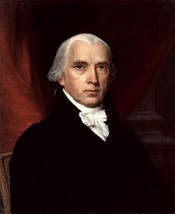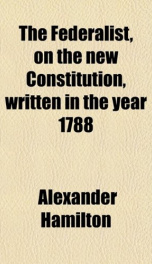Hamilton Alexander

James Madison[2] (March 16, 1751 – June 28, 1836) was an American politician and political philosopher who served as the fourth President of the United States (1809–1817), and was one of the Founding Fathers of the United States. Considered to be the "Father of the Constitution," he was the principal author of the document. In 1788, he wrote over a third of the Federalist Papers, still the most influential commentary on the Constitution. The first President to have served in the United States Congress, he was a leader in the 1st United States Congress, drafted many basic laws and was responsible for the first ten amendments to the Constitution (said to be based on the Virginia Declaration of Rights), and thus is also known as the "Father of the Bill of Rights".[3] As a political theorist, Madison's most distinctive belief was that the new republic needed checks and balances to protect individual rights from the tyranny of the majority.[4][5][6][7] As leader in the House of Representatives, Madison worked closely with President George Washington to organize the new federal government. Breaking with Treasury Secretary Alexander Hamilton in 1791, Madison and Thomas Jefferson organized what they called the Republican Party (later called the Democratic-Republican Party)[8] in opposition to key policies of the Federalists, especially the national bank and the Jay Treaty. He secretly co-authored, along with Thomas Jefferson, the Kentucky and Virginia Resolutions in 1798 to protest the Alien and Sedition Acts. As Jefferson's Secretary of State (1801–1809), Madison supervised the Louisiana Purchase, doubling the nation's size, and sponsored the ill-fated Embargo Act of 1807. As president, he led the nation into the War of 1812 against Great Britain. During and after the war, Madison reversed many of his positions. By 1815, he supported the creation of the second National Bank, a strong military, and a high tariff to protect the new factories opened during the war. James Madison was born in Port Conway, Virginia on March 16, 1751, (March 5, 1750, Old Style, Julian calendar). He grew up as the oldest of seven children to live to maturity. His father, James Madison, Sr., (1723–1801) was a planter who grew up on an estate in Orange County, Virginia, which he inherited on reaching maturity. He later acquired still more property and became the largest landowner and leading citizen of Orange County. His mother, Eleanor "Nelly" Rose Conway (1731–1829), was born at Port Conway, Virginia, the daughter of a prominent planter and tobacco merchant. Madison's parents married in 1743. Both parents had a significant influence over their most famous oldest son. Madison had three brothers and three sisters to live to maturity (by whom he had more than 30 nieces and nephews): From ages 11–16, Madison studied under Donald Robertson, an instructor at the Innes plantation in King and Queen County, Virginia. From Robertson, Madison learned math, geography, and modern and ancient languages. He became especially proficient in Latin. At age 16, he began a two-year course of study under the Reverend Thomas Martin, who tutored Madison at Montpelier in preparation for college. Unlike most college-bound Virginians of his day, Madison did not choose the College of William and Mary because the lowland climate of Williamsburg might have strained his delicate health. Instead, in 1769 he enrolled at the College of New Jersey (now Princeton University). Through diligence and long hours of study that may have damaged his health,[9] Madison graduated in two years. His studies there included Latin, Greek, science, geography, math, rhetoric, and philosophy. Great emphasis also was placed on speech and debate. After graduation, Madison remained at Princeton to study Hebrew and philosophy under university president John Witherspoon before returning to Montpelier in the spring of 1772. Madison studied law sporadically but never gained admission to the bar. James Madison married Dolley Madison, a widow with one son on September 15, 1794, in what is now Jefferson County, West Virginia. Dolley Payne Todd Madison was born on May 20, 1768, at the New Garden Quaker settlement in North Carolina, where her parents John Payne and Mary Coles Payne lived briefly. Dolley's sister (Lucy Payne) had married George Steptoe Washington, a nephew of President Washington. As a member of Congress, Madison had doubtless met the widow Todd at social functions in Philadelphia, then the nation's capital. In May 1794, he took formal notice of her by asking their mutual friend Aaron Burr to arrange a meeting. The encounter apparently went smoothly for a brisk courtship followed, and by August she had accepted his proposal of marriage. For marrying Madison, a non-Quaker, she was expelled from the Society of Friends. The Madisons had no children; thus he has no direct descendants. As a young lawyer, Madison defended Baptist preachers arrested for preaching without a license from the established Anglican Church. In addition, he worked with the preacher Elijah Craig on constitutional guarantees for religious liberty in Virginia.[10] Working on such cases helped form his ideas about religious freedom. Madison served in the Virginia state legislature (1776–79) and became known as a protégé of Thomas Jefferson. He attained prominence in Virginia politics, helping to draft the Virginia Statute for Religious Freedom. It disestablished the Church of England, and disclaimed any power of state compulsion in religious matters. He excluded Patrick Henry's plan to compel citizens to pay for a congregation of their own choice. Madison's cousin, the Right Reverend James Madison (1749–1812), became president of the College of William & Mary in 1777. Working closely with Madison and Jefferson, Bishop Madison helped lead the College through the difficult changes involving separation from both Great Britain and the Church of England. He also led college and state actions that resulted in the formation of the Episcopal Diocese of Virginia after the Revolution. James Madison persuaded Virginia to give up its claims to northwestern territories consisting of most of modern-day Ohio, Indiana, Illinois, Michigan, and Wisconsin, and part of Minnesota - to the Continental Congress, which created the Northwest Territory in 1783. These land claims overlapped partially with other claims by Connecticut, Pennsylvania, Maryland, and maybe others. All of these states ceded their westernmost lands, with the understanding that new states could be formed from the land, as they were. As a delegate to the Continental Congress (1780–83), Madison was considered a legislative workhorse and a master of parliamentary coalition building.[11] He was elected to the Virginia House of Delegates for a second time from 1784 to 1786. Madison returned to the Virginia state legislature at the close of the war. He soon grew alarmed at the fragility of the Articles of Confederation, particularly the divisiveness of state governments, and strongly advocated a new constitution. At the Philadelphia Convention in 1787, Madison's draft of the Virginia Plan and his revolutionary three-branch federal system became the basis for the American Constitution of today. Though Madison was a shy man, he was one of the more outspoken members of the Continental Congress. He envisioned a strong federal government that could overrule actions of the states when they were deemed mistaken; later in life he came to admire the US Supreme Court as it started filling that role.[12] To encourage ratification of the Constitution, Madison joined Alexander Hamilton and John Jay to write the Federalist Papers in 1787 and 1788.[13] Among other contributions, Madison wrote paper #10, in which he explained how a large country with many different interests and factions could support republican values better than a small country dominated by a few special interests. His interpretation was largely ignored at the time, but in the twentieth century became a central part of the pluralist interpretation of American politics.[14] In Virginia in 1788, Madison led the fight for ratification at the Virginia Ratifying Convention, debating with Patrick Henry and others who sought revisions (such as the United States Bill of Rights) before its ratification. Madison is often referred to as the "Father of the Constitution" for his role in its drafting and ratification. However, he protested the title as being "a credit to which I have no claim... The Constitution was not, like the fabled Goddess of Wisdom, the offspring of a single brain. It ought to be regarded as the work of many heads and many hands".[15] He wrote Hamilton at the New York ratifying convention, stating his opinion that "ratification was in toto and 'for ever'". The Virginia convention had considered conditional ratification worse than a rejection.[16] Initially Madison "adamantly maintained ... that a specific bill of rights remained unnecessary because the Constitution itself was a bill of rights."[17] Madison had three main objections to a specific bill of rights: However, the anti-Federalists demanded a bill of rights in exchange for their support for ratification. Patrick Henry persuaded the Virginia legislature not to elect Madison as one of their first Senators; but Madison was directly elected to the new United States House of Representatives and became an important leader from the First Congress (1789) through the Fourth Congress (1797). People submitted more than 200 proposals from across the new nation. Madison ignored proposals that called for structural change to the government and synthesized the remainder into a list for the protection of civil rights, such as free speech, right of the people to bear arms, and habeas corpus. Still ambiguous as late as 1788 in his support for a bill of rights,[18] in June 1789 Madison offered a package of twelve proposed amendments to the Constitution.[19] Madison completed his change in position and "hounded his colleagues relentlessly" to accept the proposed amendments.[3] By 1791, the last ten of Madison's proposed amendments were ratified and became the Bill of Rights. Contrary to his wishes, the Bill of Rights was not integrated into the main body of the Constitution, and it did not apply to the states until the passages of Fourteenth and Fifteenth Amendments restricted the powers of the states. The Second Amendment originally proposed by Madison (but not then ratified: see United States Bill of Rights) was later ratified in 1992 as the Twenty-seventh Amendment to the United States Constitution. The remaining proposal was intended to accommodate future increase in members of the House of Representatives.
do you like this author?
What readers are saying
What do you think? Write your own comment on this book!
write a commentWhat readers are saying
What do you think? Write your own comment on this author!
write a commentBook list

the federalist on the new constitution written in the year 1788
Series:
Unknown
Year:
Unknown
Raiting:
4.5/5
Purchase of this book includes free trial access to www.million-books.com where you can read more than a million books for free. This is an OCR edition with typos. Excerpt from book: THE FEDERALIST. No. 1. BY ALEXANDER HAMILTON. Introduction. After full experience of the insufficiency of the existing federal government, you are invited to deliberate upon a New Constitution for the United States of America. The subject speaks its own importance; comprehending in its consequences, nothing less than the existence of the UNION, the safety and welfare of the parts of which it is composed, the fate of an empire, in many respects, the most interesting in the world. It has been frequently remarked, that it seems to have been reserved to the people .of this country to decide, by their conduct and example, the important question, whether societies of men are really capable or not, of establishing good government from reflection and choice, or whether . they are forever destined to depend for their political constitutions, on accident and force. If there be any truth in the remark, the crisis at which we are arrived may, with propriety, be regarded as the period when that decision is to be made ; and a wrong election of the part we shall act, may, in this view, deserve to be considered as the general misfortune of mankind. This idea, by adding the inducements of philanthropy to those of patriotism, will heighten the solicitude which all considerate and good men must feel for the event. Happy will it be if our choice should be directed by a judicious estimate of our true interests, uninfluenced by considerations foreign to the public good. But this is more ardently to be wished for, than seriously to be expected. The plan offered to our deliberations, affects too many particular interests, innovates upon too many local institutions, not to involve in its discussion a variety of objects extraneous to its merits, and of views, passions and prejudices little fav...
Show more
add to favoritesadd In favorites

the federalist on the new constitution written in 1788
Series:
Unknown
Year:
Unknown
Raiting:
2.5/5
Show more
add to favoritesadd In favorites

the federalist on the new constitution volume 2
Series:
Unknown
Year:
Unknown
Raiting:
4/5
Show more
add to favoritesadd In favorites

the federalist on the new constitution volume 1
Series:
Unknown
Year:
Unknown
Raiting:
4/5
Show more
add to favoritesadd In favorites

the fate of major andr a letter from alexander hamilton to john laurens
Series:
Unknown
Year:
Unknown
Raiting:
4/5
Show more
add to favoritesadd In favorites

letters of pacificus and helvidius on the proclomation of neutrality of 1793
Series:
Unknown
Year:
Unknown
Raiting:
3/5
Show more
add to favoritesadd In favorites

letter from alexander hamilton concerning the public conduct and character of j
Series:
Unknown
Year:
Unknown
Raiting:
4/5
Show more
add to favoritesadd In favorites

federalist a span classsearchtermspan classsearchtermcollectionspan
Series:
Unknown
Year:
Unknown
Raiting:
3.5/5
Show more
add to favoritesadd In favorites

fausts pocket map and guide with a complete street directory of san francisco
Series:
Unknown
Year:
Unknown
Raiting:
3.5/5
Show more
add to favoritesadd In favorites

dramas and poems
Series:
Unknown
Year:
Unknown
Raiting:
4/5
Purchase of this book includes free trial access to www.million-books.com where you can read more than a million books for free. This is an OCR edition with typos. Excerpt from book: POEMS. TO DEAR MOTHER. 1833. Why will ye all be so gloomy and sad When smiling, our dear mother earth looks so glad, When the fish in the lake swims gaily on, And the lark sings on high, her matin song. Leave sorrow for winter'tis the spring-time of year, When earth's scenes are gaytheir heavens are clear, When the twittering birds teach their young how to fly, And on their light pinions, soar off to the sky. Then teach ye your young, by gladness and cheer, Their lot, if a sad one, with light heart to bear, That on virtue's wings they may safely fly, And reach, at the last, a haven on high. That as fall's piercing winds and winter's chill blasts Fall sharp on the ear, while we know they'll not last, And as spring-time will come and flowers will bloom, So pleasures and griefs are man's lot to the tomb. ON MOTHER'S DEATH. Septembeb, 1873. There's rare joy on high, aye, rich joy in Heaven, Bright angels have welcom'd, their sister was given, To cheer this dark earth, with its sino and its fears; Lo! she's wreathed in smiles, while we're bathed in tears. Mourn not, fond Sisters, Father, proud in love, kneel, And bowing thy head, in humility feel, Though 'reft from us here, the flower was given, Blooms with rare beauty in the bright courts of Heaven. So lovely by nature, so gentle to all, Why marvel, the angels our dear Mother call, Her voice of the spheresever gracious her ways; She shone, upon earth, oue of Heaven's bright rays. Weep not, fond Father, but on those she loved Lavish the tenderness you ever showed To our deal- mother, thy youth's chosen bride. The cherished of Heaven, thy jewel, thy pride. There's rare joy on high, aye, rich joy in Heaven, Bright angels have welcom'd, their sister was given To cheer this dar...
Show more
add to favoritesadd In favorites

a few of hamiltons letters including his description of the great west indian
Series:
Unknown
Year:
Unknown
Raiting:
5/5
Originally published in 1903. This volume from the Cornell University Library's print collections was scanned on an APT BookScan and converted to JPG 2000 format by Kirtas Technologies. All titles scanned cover to cover and pages may include marks notations and other marginalia present in the original volume.
Show more
add to favoritesadd In favorites
What readers are saying
What do you think? Write your own comment on this author!
write a commentGenre
- Books / History / Americas
- Literature & Fiction / Classics
- Literature & Fiction / General AAS
- Books / Canada / Description and travel
- Books / English language
- Law / United States
- Nonfiction / Education / Education Theory / History
- Literature & Fiction / Books & Reading / Women Writers & Feminist Theory
if you like Hamilton Alexander try:
readers also enjoyed
What readers are saying
What do you think? Write your own comment on this author!
write a commentGenre
- Books / History / Americas
- Literature & Fiction / Classics
- Literature & Fiction / General AAS
- Books / Canada / Description and travel
- Books / English language
- Law / United States
- Nonfiction / Education / Education Theory / History
- Literature & Fiction / Books & Reading / Women Writers & Feminist Theory
if you like Hamilton Alexander try:
readers also enjoyed
Do you want to exchange books? It’s EASY!
Get registered and find other users who want to give their favourite books to good hands!

